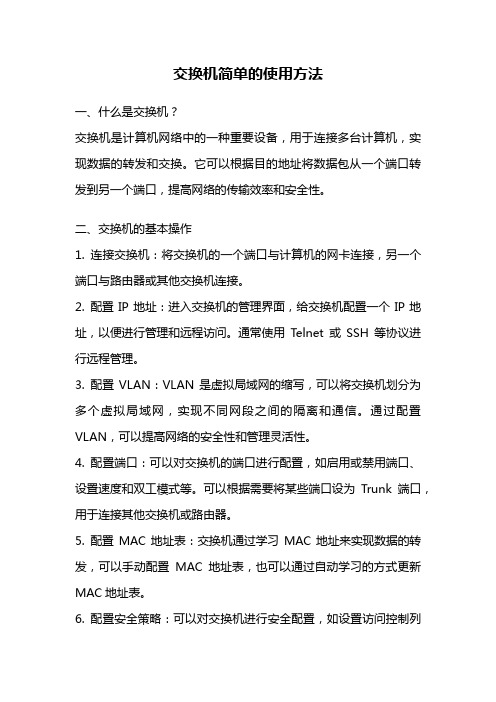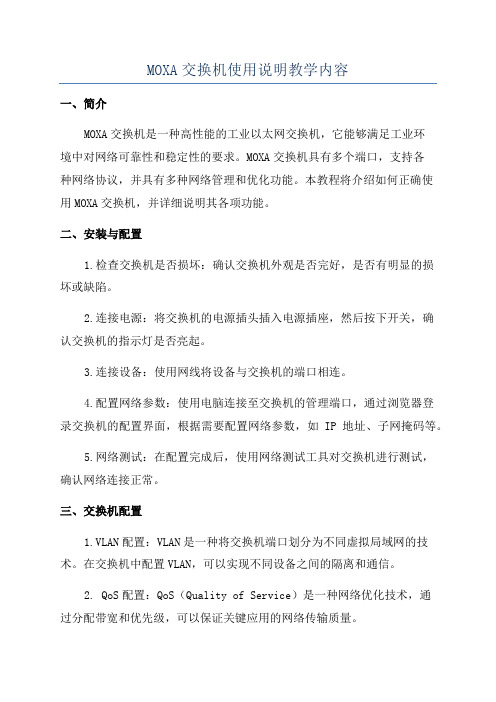网络交换机使用说明
交换机简单的使用方法

交换机简单的使用方法一、什么是交换机?交换机是计算机网络中的一种重要设备,用于连接多台计算机,实现数据的转发和交换。
它可以根据目的地址将数据包从一个端口转发到另一个端口,提高网络的传输效率和安全性。
二、交换机的基本操作1. 连接交换机:将交换机的一个端口与计算机的网卡连接,另一个端口与路由器或其他交换机连接。
2. 配置IP地址:进入交换机的管理界面,给交换机配置一个IP地址,以便进行管理和远程访问。
通常使用Telnet或SSH等协议进行远程管理。
3. 配置VLAN:VLAN是虚拟局域网的缩写,可以将交换机划分为多个虚拟局域网,实现不同网段之间的隔离和通信。
通过配置VLAN,可以提高网络的安全性和管理灵活性。
4. 配置端口:可以对交换机的端口进行配置,如启用或禁用端口、设置速度和双工模式等。
可以根据需要将某些端口设为Trunk端口,用于连接其他交换机或路由器。
5. 配置MAC地址表:交换机通过学习MAC地址来实现数据的转发,可以手动配置MAC地址表,也可以通过自动学习的方式更新MAC地址表。
6. 配置安全策略:可以对交换机进行安全配置,如设置访问控制列表(ACL)限制特定主机的访问、配置端口安全等,提高网络的安全性。
三、交换机的常见问题及解决方法1. 无法远程管理交换机:检查交换机的IP地址是否配置正确,确认管理电脑与交换机是否在同一个网段。
2. 无法上网:检查交换机的端口是否连接正确,确认网线是否插好、网卡是否启用等。
3. 网络速度慢:可能是交换机端口设置错误,可以检查端口的速度和双工模式是否匹配,或者通过查看交换机的日志来判断是否有异常。
4. VLAN隔离失败:检查交换机的VLAN配置是否正确,确认端口是否正确加入到相应的VLAN中,可以通过查看交换机的VLAN配置和端口状态来排查问题。
5. 安全问题:如果发现网络中存在恶意主机或攻击行为,可以通过配置ACL来限制其访问或阻止其攻击。
四、交换机的注意事项1. 交换机的性能和规模:在选择交换机时,要考虑网络的规模和性能需求,选择合适的交换机类型和端口数量。
MOXA交换机使用说明教学内容

MOXA交换机使用说明教学内容一、简介MOXA交换机是一种高性能的工业以太网交换机,它能够满足工业环境中对网络可靠性和稳定性的要求。
MOXA交换机具有多个端口,支持各种网络协议,并具有多种网络管理和优化功能。
本教程将介绍如何正确使用MOXA交换机,并详细说明其各项功能。
二、安装与配置1.检查交换机是否损坏:确认交换机外观是否完好,是否有明显的损坏或缺陷。
2.连接电源:将交换机的电源插头插入电源插座,然后按下开关,确认交换机的指示灯是否亮起。
3.连接设备:使用网线将设备与交换机的端口相连。
4.配置网络参数:使用电脑连接至交换机的管理端口,通过浏览器登录交换机的配置界面,根据需要配置网络参数,如IP地址、子网掩码等。
5.网络测试:在配置完成后,使用网络测试工具对交换机进行测试,确认网络连接正常。
三、交换机配置1.VLAN配置:VLAN是一种将交换机端口划分为不同虚拟局域网的技术。
在交换机中配置VLAN,可以实现不同设备之间的隔离和通信。
2. QoS配置:QoS(Quality of Service)是一种网络优化技术,通过分配带宽和优先级,可以保证关键应用的网络传输质量。
3.静态路由配置:在交换机中配置静态路由,可以实现不同子网之间的通信。
4.端口管理:配置端口速率、全双工或半双工模式、流控等参数,以充分利用网络带宽和提高网络性能。
5.网络监控与诊断:通过交换机的网络监控功能,可以实时监测网络流量、连接状态和端口的状态,以及进行故障诊断和排除。
四、安全性配置1.密码设置:修改交换机的默认登录密码,以保护设备免受未经授权的访问。
2. 限制访问:通过配置ACL(Access Control List)或MAC过滤,限制特定IP地址或MAC地址的访问。
3.HTTPS加密:将交换机的管理界面配置为使用HTTPS加密协议,提高数据传输的安全性。
4.日志记录:开启日志记录功能,记录交换机的操作和事件,以便后续分析和审计。
交换机使用说明

交换机使用说明交换机是用于构建局域网或广域网中的网络设备,它可以将网络中的各个主机进行连接,并且可以按照不同的规则进行数据传输和转发。
一、交换机的分类与功能根据交换机的功能和性能,可以将其分为以下几类:1.传统交换机:具有基本的数据传输功能,可以在不同的端口之间进行数据的转发。
2.管理型交换机:可以通过网络管理软件对交换机进行配置和管理,提供更多的功能和选项。
3.三层交换机:除了具备传统交换机的功能外,还可以进行网络层(第三层)的路由功能。
4.堆叠交换机:多个交换机通过堆叠线缆进行连接,形成一个逻辑上的交换机集群。
5.万兆交换机:提供更高的数据传输速度,适用于大型网络环境。
交换机的主要功能包括以下几个方面:1.桥接功能:交换机通过MAC地址来进行数据转发,将数据包从一个端口转发到另一个端口。
2.过滤功能:交换机可以根据MAC地址、IP地址、端口等信息对数据进行过滤,提高网络的安全性。
3.VLAN功能:可以根据需要将交换机划分为不同的虚拟局域网,实现网络资源的隔离和管理。
4.速度适配功能:交换机可以根据与设备连接的速度进行自适应,保证数据传输的稳定性和高效性。
5.QoS功能:交换机可以通过优先级和流量控制等功能,对网络中的数据进行优化和管理。
二、交换机的配置与管理1.IP地址和子网掩码的配置:在管理型交换机中,需要为交换机配置一个IP地址和子网掩码,用于进行远程管理和配置。
2.VLAN的配置:可以将交换机划分为不同的虚拟局域网,根据需要进行端口的划分和配置,实现资源的隔离和管理。
3.MAC地址表的管理:交换机通过维护一个MAC地址表来进行数据的转发,需要对该表进行管理和维护。
4.速率与双工模式的配置:交换机可以根据设备与其连接的速度和双工模式进行自适应配置,保证数据传输的稳定性和高效性。
5.QoS的配置:可以通过配置交换机的QoS功能,对网络中的数据进行优先级和流量控制,提高网络的性能和稳定性。
6. STP协议的配置:可以通过配置交换机的STP(Spanning Tree Protocol)协议,实现交换机之间的冗余路径的自动屏蔽,提高网络的可靠性。
KJJ12 矿用本安型网络交换机 使用说明书

KJJ12矿用本安型网络交换机使用说明书(版本号:1.0)执行标准:GB/T 3836.1-2021GB/T 3836.4-2021MT209-1990(抗干扰性能和可靠性除外)MT210-1990Q/320412 XZMA036-2022常州新泽监控设备有限公司发布日期2022年06月15日©常州新泽监控设备有限公司版权所有。
未经许可不得翻印、修改或引用。
为了保证安全并获得最佳效能,在安装、使用产品前,请详细阅读本使用说明书并妥善保管,以备今后参考。
敬 告敬告:在您安装和使用本产品前,请仔细阅读本使用说明书!警 告警告:一、维修时不得改变本安电路和与本安电路有关的元、器件的电气参数、规格和型号!二、本安关联产品不得随意与其它未经检验的设备连接! 三、请按本说明书正确安装电缆,否则有可能产生故障。
四、请避免金属碎屑或其他物质进入设备内部。
五、产品的维修,应由产品的制造商进行维修,如使用单位自行进行维修时,检验在征得产品制造商同意后,方可进行维修。
维修方承担产品维修后的责任。
设备维修,应由掌握、熟悉电气相关知识的专业人员进行检查和维修。
六、 维修后的设备,经检验合格后,方可投入使用。
警 告警告: 未按本说明书使用而造成的一切后果自负,在爆炸性气体环境中严禁打开!目录1、概述 (1)2、结构特征与工作原理 (1)3、技术特性 (2)3.1电气性能 (2)3.2传输距离 (2)3.3端口参数 (3)3.4转发速率 (3)3.5吞吐量 (3)3.6网络重构自愈时间 (4)3.7主要功能 (4)3.8防护等级 (4)3.9防爆型式 (4)4、尺寸、重量 (4)5、安装及调试 (5)6、故障分析与排除 (5)7、使用注意事项 (6)8、包装、运输、贮存 (6)9、开箱及检查 (6)10、售后服务 (6)I1、概述1.1用途及适用范围KJJ12矿用本安型网络交换机采用本质安全设计,适用于有瓦斯和煤尘爆炸危险的矿井下。
杭州鸿雁电器 HM10 100M-5SH 8SH 网络交换机说明书

杭州鸿雁电器有限公司5口/8口网络交换机使用说明书HM10/100M-5SH/8SH网络交换机说明书HM10/100M-5SH/8SH家用5口/8口10M/100M自适应网络交换机模块条是杭州鸿雁电器有限公司最新研制的宽带网络产品。
使用该模块可建立小型家庭局域网,同时让几台计算机上网冲浪。
每一台电脑可独享100M带宽。
安装于家庭信息接入箱内。
z产品特性1.符合IEEE802.3,802.3u与802.3x快速以太网标准2.提供5个10/100Mbps快速以太网络RJ45端口3.全部端口均支持全/半双工模式4.采用存储-转发(Store – and – forward)交换技术,可过滤不良数据包5.支持流量控制功能(全双工:Flow Control,半双工:Backpressure),有效地解决了网络阻塞问题6.1K 高效MAC地址表7.256K缓冲存储器8.线速(Wire Speed)转发,最高达1G背板带宽9.提供广播风暴抑制功能10.各端口均支持自动识别交叉线功能(Auto Crossover)11.提供指示灯,指示各端口的连接状态和数据传输状态(LINK/ACT)z交换机安装1.和家庭信息接入箱其他模块条一样,用4颗螺钉将交换机固定在家庭信息接入箱内既可。
2.接上配套电源。
3.将用户端和级连端网线插入到交换机输入输出端口中。
4.在10M/100M BASE-TX网络中,使用5类4对双绞线,接点和交换机端口的最长距离为100米。
z产品规格符合标准:IEEE802.3 10M以太网标准IEEE802.3u 100M快速以太网标准通讯协议:CSMA/CD吞吐量: 10Mbps 时,14880bps/sec(每个包64字节)100Mbps时,148800bps/sec(每个包64字节)流量控制:全双工时,采用IEEE802.3x流量控制标准半双工时,采用背压流控(Backpressure)传输模式:10/100Mbps,全/半双工。
网络交换机用户手册说明书

16 Port Nway Fast EthernetPoE Web Smart SwitchUser’s ManualVer:1.3.3- 0 -- 1 -Web Smart Switch ConfigurePlease follow the steps to configure this Web Smart switch.Step 1: Use a twisted pair cable to connect this switch to your PC.Step 2: Set your PC’s IP to 192.168.2.xx.Step 3: Open the web browser (like IE…), and go to 192.168.2.1 Then you will see the login screen.ID and the password: admin- 2 -Step 4: After the authentication procedure, the home page shows up.Select one of the configurations by clicking the icon.- Administrator - Port Management - VLAN Setting - Per Port Counter - QoS Setting - Security- Spanning Tree - Trunking- Backup/Recovery - Miscellaneous - LogoutAdministrator: Authentication Configuration1. Change the user name and the password.2. Click “Update” to confirm the new change. Now, you can use the new user name and the password.- 3 -Administrator: System IP Configuration1. Change the IP address: type the new IP address or selectDHCP IP configuration.2. Click “Update” to confirm the new change.“Setting Process OK!!” will be shown on the screen.Now, the setting of “System IP Configuration” is finished.- 4 -Administrator: System StatusMAC address and system version will be shown on the screen.1.Change the new comment of this switch by typing the newcomment.2.Click “Update” to confirm the new change.Now, the setting of “System Status” is finished.- 5 -Administrator: Load Default Setting1.Click “Load” to back to the factory default setting.**Note: Recover switch default setting excluding the IP address, User name and Password.Now, the default is loaded.- 6 -Administrator: Firmware UpdateFollow the instruction on the screen to update the new firmware. Please contact with your sales agents to get the latest firmware information.- 7 -Administrator: Reboot Device1. Click “Confirm” to reboot the device. Now, the setting of “Reboot Device” is finished.- 8 -Port Management: Port ConfigurationSelect the “Port No.” - configure the mode below:1. “Auto-Nego” - enable/disable Auto-Negotiation.2. “Speed” - 10M or 100M mode for the selected port.3.“Duplex” - Full or Half-Duplex mode for the selected port.4. “Pause” - enable/disable for the selected port.5. “Backpressure” - enable/disable for the selected port.6. “Tx Cap (Capability) ” - enable/disable for the selected port.7. “Addr. Learning” - enable/disable for the selected port. Now, the setting of “Port Configuration” is finished.- 9 -Port Management: Port MirroringPort Mirroring is used to mirror traffic, RX, TX or TX&RX, from Source port to Destination port for analysis.1.Select the Destination port: you can choose port 1 to port 162.Select the Source port: by clicking the checking box of theport.3.Click “Update” to save the setting.Now, the setting of “Port Mirroring” is finished.- 10 -Port Management: Bandwidth Control1.Select the “Port No.”: you can choose port 1 to port 162.“TX Rate Value”: set the transmission rate of the selected port.(0:Full speed; 1~255:Specified bandwidth.)3.“RX Rate Value”: set the receiving rate of the selected port. (0:Full speed; 1~255: Specified bandwidth.)4.“Resolution” : Low: 32 kbps / High: 512 kbps5.Click “Update” to confirm the setting or “LoadDefault”. Now, the setting of “Bandwidth Control” is finished.- 11 -Port Management: Broadcast Storm Control1.“Threshold” - Set the threshold from 1~63.2.“Enable Port” - per port to define the status of broadcast packets.3.Click “Update” to confirm the setting.Now, the setting of “Broadcast Storm Control” is finished.- 12 -Port Management: PoE ConfigurationRemote access and monitor the attached PD (Powered Device) status by using Enable/Disable function.1.Enable: POE of the port is able to supply power to the attachedPD (Powered Device)2.PSE Current & Minimum Output Power: The status of theport current and minimum output power.3. POE class: each POE port will detect the class of the attachedPD (Powered Device)4. Click “Update” to confirm and finish the setting.Now, the setting of “PoE Configuration” is finished.- 13 -VLAN Setting: VLAN ModeThere are two VLAN modes : Port Based VLAN and Tagged VLAN. Click “Change VLAN mode” to select the mode.**If the Port Based VLAN function is enabled, Multi to 2 setting and tag Based VLAN will be disabled automatically.Now, the setting of “VLAN Mode” is finished.- 14 -VLAN Setting: VLAN Member Setting (Port Based)You can select a port group.1. Click the port numbers: which you want to put them into theselected VLAN group.2. Click “Update” to confirm and finish the setting.3. Click “LoadDefualt” to back to the original factory setting. Now, the setting of “VLAN Mode” is finished.- 15 -VLAN Setting: Multi to 2 SettingThis is a special design for easily setting the switch VLAN into “VLAN Per Port“.1.Choose “Destination Port No”.2.Choose “Disable Port”3.“Disable Port” – choose the port which you don’t want to use4.Click “Update” to confirm and finish the setting.After this setting, all ports can only connect to destination ports.- 16 -Per Port Counter: Counter CategoryYou can read the transmitting and receiving packet of the connecting port.Click “Refresh” or “Clear” the data.- 17 -QoS Setting: Priority ModeThere are three Priority Modes to select.1.“First-in-First-Out” - the first receiving packet will be firstlytransmitted.2.“All-High-before-Low” – All packets will be assigned to eitherQ2(high) piority queue or Q1(low)priority queue.3.“4 Queue WRR (Weight-Round-Robin)” - set the ratio ofthe transmitting packet for the low priority to high priority. 4.Click “Update” to confirm and finish the setting.- 18 -- 19 - QoS Setting: Class of ServiceYou can set QoS mode of per port by different bases.TCP/UDP > TP TPS/DS > 802.1P > Physical port1.“TCP/UDP Port” – Q1 ~ Q4 options are effective for theselected physical port only. “Drop” option is the global setting for all physical ports.The packet queue will be transferred based on the number of “4 Queue WRR” on QoS Setting: Priority Mode.**WRR –Q1/Q2/Q3/Q4**“Drop” - packets will be dropped.2. “IP TOS/DS” – “Priority Setting”: Q1 ~ Q4; “IP TOS/DS PortSetting” - It means the packets with special IP will befirstly transmitted.3. “802.1p” – Priority mapping table as the screen shown.4. “Physical port” - you can select the port which you want toconfigure as Q1~Q4 priority.5. Click “Update” to confirm and finish the setting.Now, the setting of “Class of Service” is finished.- 20 -Security: MAC Address FilterSet special MAC address to activate on the selected port1.Choose “Select Port” – port 1~162.“Binding” – “Enable”: allow the packet with the specifiedsource MAC address to enter this port.3.Click “Update” to confirm and finish the setting.Now, the setting of “MAC Address Filter” is finished.- 21 -Security: TCP_UDP Filter ConfigurationYou can enable or disable this function of per port.If the “Function Enable” is “Enable”, please kindly check the following setting:1.“Port Filtering Rule” –“Deny”: the outgoing packets to the selected port with selected- 22 -protocol will be dropped and other protocols will beforwarded.“Allow”: the selected protocol will be forwarded and otherprotocol will be dropped.2.“Secure Port” – choose secure ports which you want.**Note 1:a.The secure WAN port should be set at the physical portwhich is connected to the server.b.Once this function is enabled, the switch will check thedestination TCP/UTP port number at the outgoing directionof the secure WAN port.If the condition matches, this packet will be dropped or forwarded.**Note 2: The description of Secure WAN port is shown on the bottom of this screen.3. “Protocol” – choose protocols which you want.4. Click “Update” to confirm and finish the setting.Now, the setting of “TCP/UDP Filter Configuration” is finished.- 23 -Spanning Tree: STP Bridge SettingsThis setting is to avoid the loop network.1.Select the “STP Mode”- choose “Disable”, “STP” or “RSTP”2.Set the “Bridge Priority” – Set the priority of the Bridge3.Set the period of “Hello Time” packet – Provides the time periodbetween root bridge configuration messages.4.Set the “Max Age” – Indicates when the current configurationmessage should be deleted.5.Set the “Forward Delay” time – Provides the length of time thatbridges should wait before transitioning to a new state after a topology change. (If a bridge transitions too soon, not all network links might be ready to change their state, and loops can result.)6. Click “Update” to confirm and finish the setting.Now, the setting of “STP Bridge Settings” is finished.- 24 -Spanning Tree: STP Port Settings1.Choose “Port No.” : Port 1 ~ Port 162. Choose “Priority”: 0~ 2403. “RPC” = Root Path Cost: 0 = AUTO. When the loop is found, the STP/RSTP will calculate the cost of its path.- 25 -Trunking: Link Aggregation SettingsThere are two groups to choose and max. for each group is 4 ports. Click “Submit” to confirm and finish the setting.“State” – Enable / Disable“Type” – LACP/ Static“Activity” – Active/Passive: Both switches use “LACP” to configure the Trunk, at least one of them should be “Active”.- 26 -Backup/RecoveryFollow the instruction on the screen to update the original setting. “Backup” - Click “Download” to confirm the setting. “Recovery” – select a file and key in the password Click “Update”to confirm the setting.- 27 -Miscellaneous: Miscellaneous Setting1.“Output Queue Aging Time” - You can set queue aging time intodifferent milliseconds or disable this function.2.“VLAN Striding” – You can enable/disable this function.3.“IGMP Snooping V1 & V2” – You can enable/disable thisfunction.4.“VLAN Uplink Setting” – Set “uplink1 or uplink2” or “Clearuplink1” or “Clear uplink2”5.Click “Update” to confirm and finish the setting.6.- 28 -Logout: You can click “Logout” to logout.- 29 -。
rg-nbs2028g-e-p使用说明书

rg-nbs2028g-e-p使用说明书RG-NBS2028G-E-P使用说明书一、概述RG-NBS2028G-E-P是一款高性能的网络交换机,适用于中小型企业和办公环境。
该交换机具有多个端口和功能,可以实现高速数据传输和网络管理,提供稳定可靠的网络连接。
二、外观和接口RG-NBS2028G-E-P的外观设计简洁大方,采用了紧凑型的机箱,便于安装和布局。
其背板提供了多个接口,包括光纤口、千兆以太网口和电源接口等。
用户可以根据实际需求选择合适的接口进行连接。
三、性能和功能1. 高速传输:RG-NBS2028G-E-P支持千兆以太网传输,具有出色的数据传输速度和带宽,可以满足大规模数据传输的需求。
2. 交换功能:该交换机支持VLAN(虚拟局域网)功能,可以将局域网划分为多个逻辑子网,提高网络的安全性和灵活性。
3. QoS(服务质量)管理:RG-NBS2028G-E-P支持QoS功能,可以根据不同应用程序和数据流的优先级进行流量控制和调度,确保关键应用的通信质量。
4. 安全性:该交换机支持MAC地址过滤、访问控制列表(ACL)和端口安全等功能,可以有效防止未经授权的访问和网络攻击。
5. 管理和监控:RG-NBS2028G-E-P提供了丰富的管理和监控功能,包括Web界面、命令行界面、SNMP(简单网络管理协议)和RMON(远程网络监视)等,方便用户进行网络配置和故障排除。
四、使用步骤1. 连接电源:将RG-NBS2028G-E-P的电源线插入电源插座,并确保插头与插座连接牢固。
2. 连接网络:将需要接入交换机的设备使用网线连接到交换机的相应端口上,确保连接稳定可靠。
3. 配置参数:根据实际需求,使用Web界面或命令行界面登录交换机,并进行网络参数的配置,如IP地址、子网掩码、网关等。
4. VLAN划分:根据需要,使用交换机的VLAN功能将局域网划分为多个逻辑子网,提高网络的安全性和性能。
5. QoS设置:根据不同应用程序和数据流的优先级,设置交换机的QoS参数,以保证关键应用的通信质量。
网络交换机H3C_S1016使用说明

网络交换机H3C_S1016使用说明H3C_S1016是一种网络交换机,用于将多个网络设备进行连接和通信。
它是一款16口千兆以太网交换机,以其高性能和可靠性而广泛应用于各种网络环境中。
下面是对H3C_S1016网络交换机的详细使用说明。
一、H3C_S1016的基本功能介绍H3C_S1016具有以下基本功能:1.16个千兆以太网接口,用于连接多台设备。
2. 支持IEEE 802.3x流控制和IEEE 802.3az节能以太网标准。
3.自动协商速率和全双工/半双工模式。
4.支持VLAN(虚拟局域网)和QoS(质量保证)功能。
5.交换机本身具有防火墙、入侵检测和访问控制等功能。
二、H3C_S1016的硬件连接1.使用网线将交换机的一个端口连接到路由器或上级交换机上的一个端口。
2.使用网线将需要连接的设备连接到交换机的其他端口上。
3.连接电源线,确保交换机正常工作。
三、H3C_S1016的配置与管理1.打开电脑上的浏览器,并输入交换机的管理IP地址。
2.输入管理员登录名和密码进行登陆。
3.进入管理界面后,可以对交换机进行各种配置和管理操作。
4.可以配置VLAN、QoS、端口安全等功能。
5.可以通过管理界面查看交换机的状态、连接设备等信息。
四、H3C_S1016的常用配置操作1.配置VLAN:可以将交换机的端口进行划分,不同的VLAN之间无法进行通信。
2.配置QoS:可以对交换机的端口进行流量控制和优先级设置,确保重要数据的传输质量。
3.配置端口安全:可以对交换机的端口进行限制,只允许特定设备连接。
4.配置链路聚合:可以将多个端口进行聚合,提高带宽和可靠性。
5.查看交换机状态:可以查看交换机的CPU利用率、内存利用率、链路状态等信息。
五、H3C_S1016的故障处理和维护管理1.在管理界面查看交换机运行日志,以了解交换机是否有异常情况。
2.如果有端口无法正常工作,可以通过替换网线或更换端口进行故障排除。
3.定期备份交换机的配置文件,以防数据丢失。
- 1、下载文档前请自行甄别文档内容的完整性,平台不提供额外的编辑、内容补充、找答案等附加服务。
- 2、"仅部分预览"的文档,不可在线预览部分如存在完整性等问题,可反馈申请退款(可完整预览的文档不适用该条件!)。
- 3、如文档侵犯您的权益,请联系客服反馈,我们会尽快为您处理(人工客服工作时间:9:00-18:30)。
网络交换机使用说明
一、硬件配置
根据不同应用环境,设计了2种硬件类型板卡,每种类型板卡都可用于报文记录仪和录波器。
类型1,全光口配置:1个主千兆光口,6个从百兆光口;或者1个主百兆光口,6个从百兆光口。
类型2,全电口配置:1个主千兆电口,6个从百兆电口。
光口电口混合配置:1个主千兆光口,6个从百兆电口。
二、功能
报文记录仪使用:把6个百兆口来的数据包汇聚到主网口输出。
不需要参数配置。
录波器使用:
● 接收各个网口来的数据包,按照预设的目的地址组划分,转发到相应的网口输出,不设置不转发。
共7个网口,所以共有7个转发方向。
其中最顶端网口编号为1,最底端主网口的编号为7。
● 类型1全光口板的主光口默认配置速度为千兆口,主光口模块可带电插拔程序自动识别。
● 类型2主网口(光口或电口)都为千兆口。
● 使用前通过配置软件对各个数据包根据目的地址进行设置,规定其出口。
● 配置端口规定为第一个百兆网口。
三、FPGA 程序
有2个程序版本,一个用于报文记录仪使用,另一个录波器用。
四、配置软件安装
如
果初次安装,电脑上还没有.net framework 环境则需要拷贝完整安装文件,包括以下部
分:
安装的时候点击setup.exe, 如果电脑上还已经有.net framework 环境,则安装时候只需
安装文件即可,点击安装,按照默认一步一步安装完成后会提示是否安装
,如果以前已经安装则点击否就行了,点击是重新安装也没问题。
五、配置软件使用
1,主界面
2,工具栏按钮说明
a,下发配置:将当前配置发送到交换机;
b,读取配置:将交换机配置读取到本机并显示在主界面上;
c,打开配置:打开本地配置文件并显示到主界面上;
d,保存配置:将主界面当前配置保存到本地配置文件;
e,开始测试:启动线程,不间断的向交换机发送数据;
f,停止测试:停止“开始测试”按钮开启的测试;
g,中断数据:中断和交换机的数据传输;
h,设置Mac:
设置mac地址的范围,主界面中的mac地址在起始地址和结束地址之间循环(如果结束地址和起始地
址之间的mac地址数小于总的Mac地址数)。
注意起始地址和结束地址只能有一段不一样,否则会报如下错误:
i,退出:退出系统;
j,读超时,设置的时间是读取交换机配置信息时的超时时间,以50ms为单位设置;
k,mac地址数:要配置的mac地址数目,主界面的mac地址会随着这个数目而改变;
3,状态栏说明
状态栏左侧为公司名称log,右侧为实时通信状态。
4,操作说明
每个mac地址包括以下几部分,如图:
删除按钮:删除掉该mac地址,后面mac地址前移;
mac序号:只读,表示该mac地址的位置;
端口状态:表示每个端口的状态,第7口为千兆网口,每个网口有两种状态,选中状态和未选中状态,在该端口上左键单击切换选中状态,;注意选中的端口最多有3个;
mac地址输入端口的mac地址;
5、设置举例
在主界面截图中,设置了116个需要转发的mac地址。
对每一个mac地址都可以根据需要选定其出口,打钩为选定。
设置完毕,要保存到交换机板内eeprom中,点击“下发配置”,配置成功后设置结束。
点击“保存配置”,把界面配置内容单独保存,以后使用时可以调出。
点击“打开配置”,把以前保存的配置信息调出。
点击“读取配置”,可以把板卡内的配置信息读出使用。
配置完成,立即生效。
2012-6-20 第二版。
